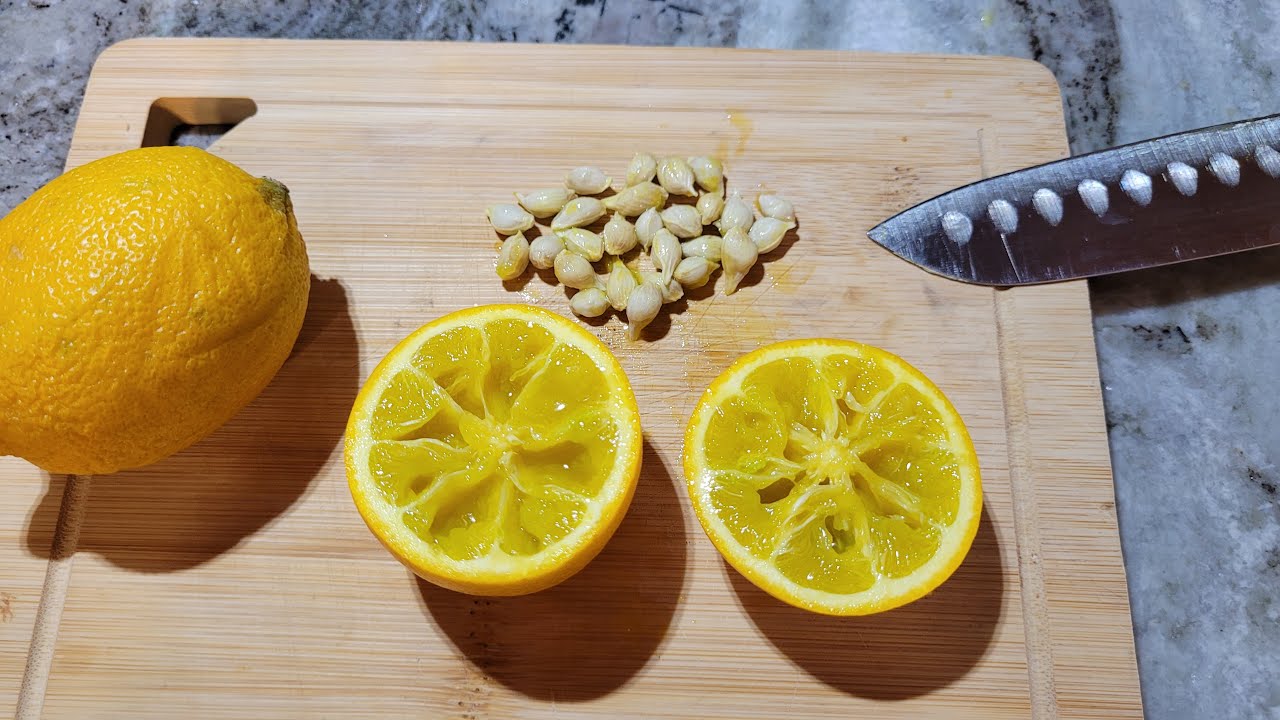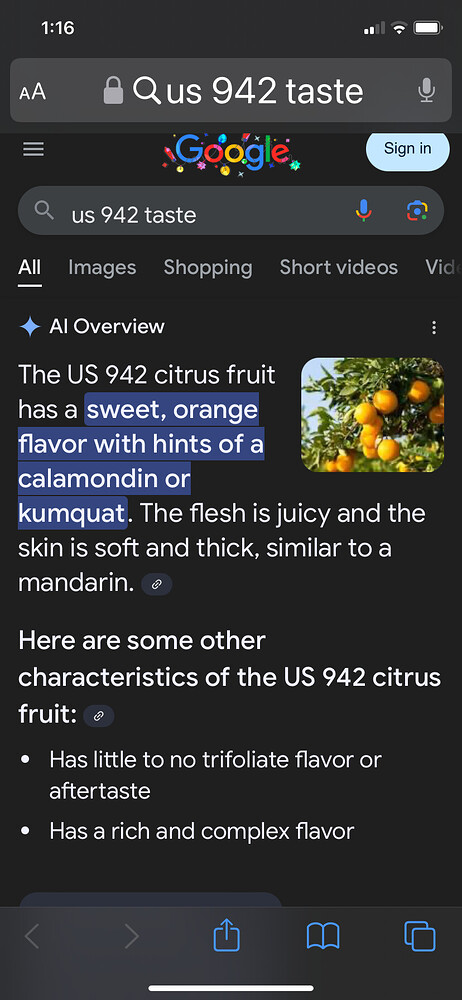I would very much like that! That sounds encouraging. I would kind of like to try my hand at breeding better fruit quality or more cold hardiness into Trifoliate orange.
Ahh, in that case I’ll also direct you towards the Tropical Fruit Forum. Several breeding projects that folks are currently working on are described there, and there’s a lot of very good information about citrus breeding as well, which is good because citrus breeding has some precious and unique challenges. For example most citrus set predominantly nucellar seeds, which means that, regardless of pollination, the resulting seedlings are generic clones of the mother tree. Only some varieties produce usable numbers of zygotic (sexually produced seeds, which is what you want for breeding) seeds and fewer still produce purely zygotic seeds.
That being said, citrus are fairly precocious, and above zone 9 or so they’re basically pest free in most parts of the country. They also respond pretty well to fertilization so growing them out is not terribly slow. They’re also very adaptable plants that can handle sun to part shade better then most fruit trees and also quite drought tolerant once established.
I have already done some reading there!
You’re in an interesting zone as far as could hardy citrus goes. Technically, zone 6a is too cold for anything but pure trifoliate orange (like Poncirus Plus) so any trifoliate hybrids are likely to be like by your winters, especially if still small. Generally, trifoliate hybrids with regular citrus are only hardy to between 0 F and 10 F depending on the variety. However, in some ways that’s an advantage. See, in the F2 generation, some hybrids take on a bit more trifoliate character and are hardier than their parents, potentially into the sub zero range. Sure, most trifoliate hybrids produce mostly nucellar seeds, and differentiating clones from true seedlings is really hard and can take years out require genetic testing, but if say you had winters that are cold enough to kill the clones but not cold enough to kill the more hardy zygotic seedlings, well then you’ve got a very easy method for weeding out all the clones.
A fellow in Pennsylvania pioneered that method. About six years ago he planted literally tens of thousands of seeds from a common rootstock trifoliate hybrid. After a few winters, only a few dozen were left. Those are the Conestoga citruses. They’re very rare still but he’s shared material with some folks on the tropical fruit forum who’ve grafted them and are growing them out. While none of them are desert quality, many are looking like improvements over regular trifoliate. He’s still working on the project, and a few other people have started their own versions of the project in other parts of the country. One thing that makes it comparatively easy to get started is that bulk citrus rootstock seeds are commercially available in pretty significant quantities.
Anyway, that’s one technique that would work well in your area I suspect. Other folks use greenhouses or winter protection and manually screen for hybrid seedlings or use fully zygotic parents. That’s more similar to what I’m doing for example, but I’m in a warm enough zone that there are fully zygotic varieties I can work with with minimal or no winter protection. As of yet, there aren’t any fully zygotic varieties that are hardy to below zero, though US-1279 gets close and Ichang papeda is hardy to about zero, and of course a few varieties like Bishop citrandarin have fairly high rates of zygotic seeds and are very hardy.
Very cool! Yeah it’s a great resource. There are a few older messages boards but TFF is honestly the only one you need, especially given your zone.
Yeah we got a winter down to -28 a couple years ago, but we only get a sub -20 every 10 or so years.
Thats one of the threads I’m on is the one by Kumin with those 40000+ seedlings.
Now, if you give me a decade or so, I might could have some F2 seeds of Poncirus Plus x (Ichang Papeda x Meyer Lemon) for you to trial.
Ok, might be a bit more than ten years for the F2 generation, but still. Something along those lines will be very hardy and ought to taste similar to a true lemon, it’s just a case of running the numbers until a good variant pops up. Back of the envelope calculations, using the very hand wave heavy assumption of F1 hardiness is around the midpoint and F2 is about 50% up or down, and assuming PP is -15 F, Ichang Papeda is 0 F and Meyer is an optimistic 15 F, would give you an F1 hybrid hardy to around -7 F and an F2 that might could get down to -10 F or so. Again, very roughly speaking.
Actually, the F3 generation would be the one to do mass trials of. Both zygotic seed and deciduous leaves appear to be recessive traits in citrus. F1 Poncirus Plus x (Ichang Papeda x Meyer Lemon) would likely been evergreen and mostly nucellar, but theoretically ¼ of its zygotic seedlings would be deciduous and have fully zygotic seeds. So one could select a few of the F2 seedlings that have those two traits, regardless of fruit quality and hardiness, and then from them get a huge number of F3 seedlings, all of which should be deciduous and none of which would be nucellar clones so one doesn’t have to worry about screening. That large F3 generation would be the one to select from for fruit quality and cold hardiness.
Hmmm, that’s probably about a twenty year project. But theoretically it should give a good chance at a deciduous (very important for hardiness and resistance to wind desiccation in the winter), lemon like citrus with sub zero hardiness.
Holy smokes that’s cold!
Good, it’s a long thread but it’s super interesting.
I would game for trialing. The -28° is our record low over the past 50 years where our house is which is a valley (cold pocket), so there are spots that are a lot warmer; for instance in our old trench silo, weeds that die at the first frost are still green, even though we’ve had temperature down in the low teens.
I’m 8b or 9a both would definitely be hardy right? I mean the Morton and Carrizo.
Where did you source your citrange specimens? McKenzie?
Yes for sure would do fine there. My Carizzo came from Madison Citrus Nursery as the rootstock for my now dead Yuzu, the Morton came from Fruit Wood Nursery but they no longer carry citrus.
Pretty sure in 8b/9a you can grow all of the 50% hybrids and even a lot of “dessert quality” citrus satsumas, kumquats, etc
I managed to kill a meyer lemon and a Mexicola avocado in Santa Rosa, California, zone 9b.
I noticed that Madison sells rootstocks, but they don’t specify what they are.
I don’t see carizzo for sale on their rootstock page. Perhaps they don’t use it anymore but you can always send them a message and find out
Thanks. That’s a fine idea. The US 812 looks like the most promising of their selection.
What makes it a poncirus plus? Better fruit? Larger fruit?
I have a, supposedly, hardy grapefruit cross (like Dunstan). I have 3 of these and I’ve noticed that one of them has significantly longer thorns than the others. Is thorn size correlated in any way to greater or lesser hardiness? I can say that this one doesn’t seem to be having its leaves change color like the other ones.
My plan is to plant one of these at work as we have a 50 by 50 courtyard surrounded on 4 sides by brick walls. The top is open but I’m optimistic it may work.
The fruit do not contain the bitter resin that normal trifoliate has. Some people have said the fruit is also a bit bigger and that it has more zygotic seed, but I’ve only seen some claims of that. The main thing is not having that resin.
Not in my experience, no.
If you’re unsure of if it’ll be hardy enough, you can always get a trifoliate rootstock and graft to it. The rootstock might add a little hardiness but the main thing is you won’t lose the mother tree if the grafted tree dies. Zone 6 is pretty darn cold, even with a microclimate.
Have you ever tried the fruit?
Your plan is to plant the dunstan in 6a? Are they rated for zone 6?
Picked a small Morton fruit from the tiny tree in the video. It was not horrible, but it does have some slight off flavors, I tasted carrot and some seawater? hard to describe lol. If it can grow outside unprotected where oranges can’t it wouldn’t be the worst idea, but there are better citrandarins out there that are not only better tasting but are hardier than these citranges (I have only tried one citrandarin and it wasn’t great, it also left a burning sensation on my tongue. I don’t remember what it was but I can say the Morton was better)
Some other decent ones we grow in 9a are clem-yuzu, sudachi and silver hill mandarin. All would definitely thrive in your greenhouse temps. I also have Meyer, xie Shan mandarin and trovita orange that handle temps in the high teens for short duration. Coldest so far they have endured is 18 F for a few hours.
The US 942 is supposed to be the best tasting citrandarin with almost no off flavors. Madison Citrus has them currently in 3 gallon size. It is 50% flying dragon so very hardy. The fruit’s taste is comparable to a calamondin, though slightly larger. Supposedly fully hardy in zone 7. Though I would be careful and cover it the first 2 winters.

